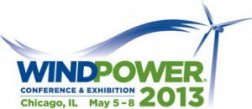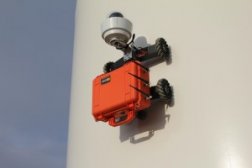 « Back to Home Page
« Back to Home Page
I attended the AWEA WINDPOWER 2013 Conference & Exhibition in Chicago earlier this week, the premiere gathering for wind industry leaders. This year, there was a lot of talk about how to make operations smarter. I found three products that caught my eye, by helping to make wind energy more reliable and efficient.
Grok
I had a lively conversation with Joe Zarb, the VP of Market Development and Tansy Brook, Director of Marketing for Grok, a company dedicated to smarter networks to predict outcomes and anomalies. The intelligence platform provides a brain for a given asset, continuously learning to improve its precision.
Grok strives to make data smarter. “You take data in real time, make decisions on that data and then take corrective actions, ” says Zarb.”
 In the wind energy industry, Grok helps replace failure-based maintenance with predictive maintenance, boosting the reliability of energy output by reducing down time. If wear to parts can be detected before they break, replacements can be ordered and even replaced before equipment fails or output is inhibited.
In the wind energy industry, Grok helps replace failure-based maintenance with predictive maintenance, boosting the reliability of energy output by reducing down time. If wear to parts can be detected before they break, replacements can be ordered and even replaced before equipment fails or output is inhibited.
“It isn’t just about big data, lots of data- it’s about fast data. As that data is streaming in, we need to make decisions, ” says Joe Zarb. “These [wind turbine] devices are extremely expensive and if they break down, it’s very costly.”
Maxwell Technologies
A wind turbine pitch control system is essential for protecting wind turbines, by allowing turbine operators to change the angle of a turbine blade to halt turbine rotations when needed. Electrical pitch systems contain either batteries or ultracapacitors as a power source.
 Although ultracapacitor technology is largely unknown to most people, it is a hot spot in wind energy advancements. Ultracapacitors are ideal when a big burst of power is needed for a short period of time. They have a much longer life than batteries and perform well under extreme temperature conditions. In my conversation with Charles Cook, Sales Application Engineer for Maxwell Technologies, he took what I thought was a dull topic and made it really interesting.
Although ultracapacitor technology is largely unknown to most people, it is a hot spot in wind energy advancements. Ultracapacitors are ideal when a big burst of power is needed for a short period of time. They have a much longer life than batteries and perform well under extreme temperature conditions. In my conversation with Charles Cook, Sales Application Engineer for Maxwell Technologies, he took what I thought was a dull topic and made it really interesting.
“I think what has really allowed ultracapacitors to grow in the market place is the lower cost, ” explains Cook. “The cost of ultracapacitors five or ten years ago was economically unfeasible. As volume has come up and we’ve improved manufacturing capabilities, we’ve been able to drop the cost of ultracapacitors and they now make a lot of sense.”
Unlike batteries in pitch control systems, ultracapacitors do not require such sophisticated monitoring and charging systems. They provide a cleaner, longer-lasting alternative to batteries and contain primarily carbon and aluminum.
Given the location of the batteries in pitch control systems, it is extremely appealing to have a long-lasting alternative to reduce replacement costs and downtime of turbines. “It’s a big deal to climb up into the hub of a 100-meter wind turbine with a bunch of lead acid batteries to change them out, ” says Cook.







